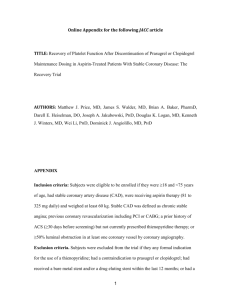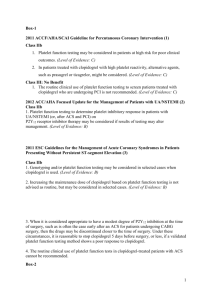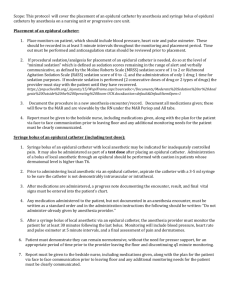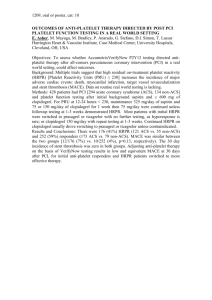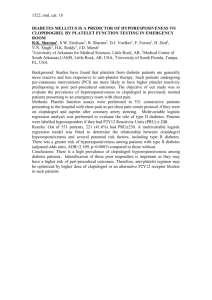safe removal of epidural catheter-a dilemma, in patients who are
advertisement
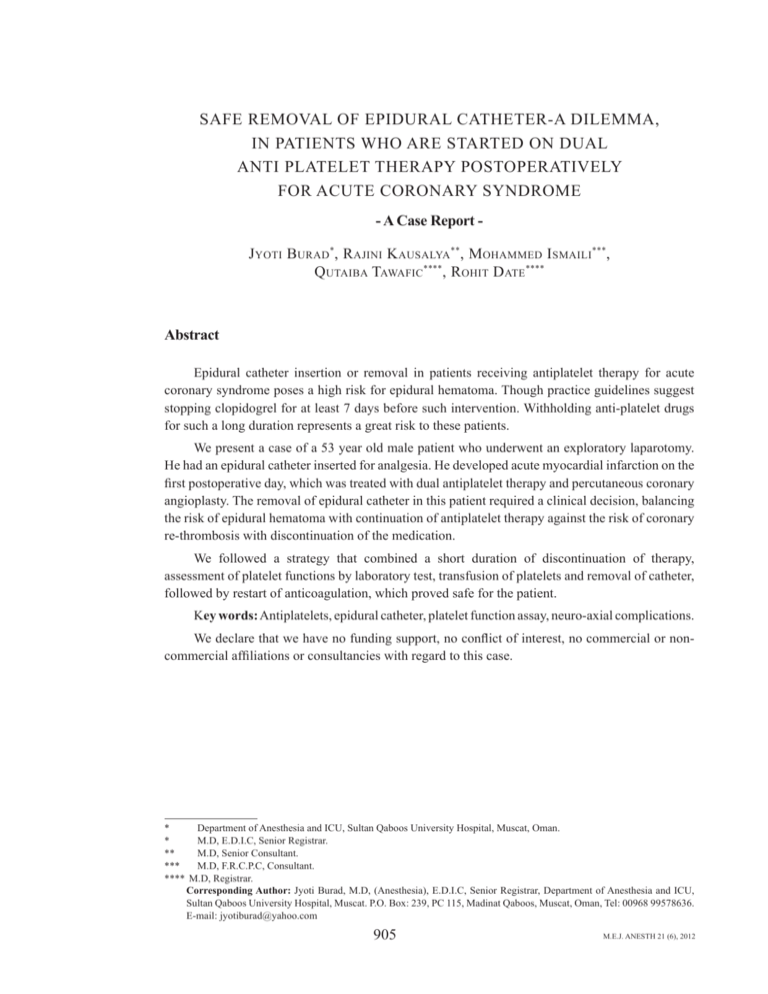
SAFE REMOVAL OF EPIDURAL CATHETER-A DILEMMA, IN PATIENTS WHO ARE STARTED ON DUAL ANTI PLATELET THERAPY POSTOPERATIVELY FOR ACUTE CORONARY SYNDROME - A Case Report Jyoti Burad*, Rajini Kausalya**, Mohammed Ismaili***, Qutaiba Tawafic****, Rohit Date**** Abstract Epidural catheter insertion or removal in patients receiving antiplatelet therapy for acute coronary syndrome poses a high risk for epidural hematoma. Though practice guidelines suggest stopping clopidogrel for at least 7 days before such intervention. Withholding anti-platelet drugs for such a long duration represents a great risk to these patients. We present a case of a 53 year old male patient who underwent an exploratory laparotomy. He had an epidural catheter inserted for analgesia. He developed acute myocardial infarction on the first postoperative day, which was treated with dual antiplatelet therapy and percutaneous coronary angioplasty. The removal of epidural catheter in this patient required a clinical decision, balancing the risk of epidural hematoma with continuation of antiplatelet therapy against the risk of coronary re-thrombosis with discontinuation of the medication. We followed a strategy that combined a short duration of discontinuation of therapy, assessment of platelet functions by laboratory test, transfusion of platelets and removal of catheter, followed by restart of anticoagulation, which proved safe for the patient. Key words: Antiplatelets, epidural catheter, platelet function assay, neuro-axial complications. We declare that we have no funding support, no conflict of interest, no commercial or noncommercial affiliations or consultancies with regard to this case. * Department of Anesthesia and ICU, Sultan Qaboos University Hospital, Muscat, Oman. * M.D, E.D.I.C, Senior Registrar. ** M.D, Senior Consultant. *** M.D, F.R.C.P.C, Consultant. **** M.D, Registrar. Corresponding Author: Jyoti Burad, M.D, (Anesthesia), E.D.I.C, Senior Registrar, Department of Anesthesia and ICU, Sultan Qaboos University Hospital, Muscat. P.O. Box: 239, PC 115, Madinat Qaboos, Muscat, Oman, Tel: 00968 99578636. E-mail: jyotiburad@yahoo.com 905 M.E.J. ANESTH 21 (6), 2012 906 Case Report A 53 year old male patient was admitted to our hospital with small bowel ischemia with past medical history of stable ischemic heart disease and no active episodes in the last six months. The surgeon decided for emergency laparotomy. Epidural catheter was inserted at T8-T9 level using aseptic technique and an infusion of bupivacaine and fentanyl was started. Subsequently, general anesthesia was induced. Intraoperative analgesia was achieved effectively with epidural infusion. Intraarterial blood pressure and central venous pressure were monitored. Patient was hemodynamically and metabolically stable throughout. He was transfused with two units of packed red blood cells to compensate for surgical blood loss. At the end of the surgery, the patient was stable and he was extubated on operating table. Patient was shifted to Intensive Care Unit (ICU) for overnight observation. Baseline investigations 2 hours postoperative, revealed an acute anterior-inferior ST elevation myocardial infarct on ECG (electrocardiogram) and the first Troponin-I value reported was 11 (normal <.04 µg/l). The patient was comfortable, completely pain-free on epidural infusion. Surprisingly, he was hemodynamically stable with normal central venous pressure and urine output. The cardiologist decided for immediate Percutaneous Coronary Intervention (PCI). He was given antiplatelet drugs (loading dose of clopidogrel 600mg and aspirin 300mg). Angioplasty and balloon dilatation of the involved coronaries were performed. The patient tolerated the procedure well. He was started on therapeutic dose of low molecular weight heparin (LMWH; Enoxaparin 60mg) twice daily. A decision to remove the epidural catheter by the end of the first post operative week was made to prevent infection of the neuraxial compartment. A multidisciplinary meeting with cardiologist, general surgeon, hematologist and intensivist was held and it was decided that the antiplatelet drugs can temporarily be withheld for the purpose of removing the epidural catheter. On fourth postoperative day clopidogrel and aspirin were put on-hold. As per the advice of the hematologist and availability of the test, platelet function was assessed twenty four hours later Burad j. et. al by Platelet function analyzer (PFA 100); Closure time was found to be 197 seconds (normal range of 96-197 seconds). Despite of the normal closure time, it was decided to transfuse platelets to the patient after 48 hours of stopping aspirin and clopidogrel. Enoxaparin was discontinued on day 4. Twelve hours after enoxaparin cessation, infusion of un-fractionated heparin was started. Activated partial thromboplastin time (APTT) was maintained at 2 to 2.5 times of the normal. The heparin infusion was stopped after 12 hours. Coagulation profile was checked and was reported to be normal. Platelets were transfused and epidural catheter was removed after 2 hours. The antiplatelet drugs and LMWH were restarted 2 hours later. Patient was observed in the ICU for another two days, for development of neurologic or cardiac complications. He developed neither and was discharged to the ward. Discussion The incidence of ischemic heart disease is rising. So is the use of antiplatelet drugs in managing such cases. The safety of regional anesthesia in patients who are already on antiplatelet drugs is controversial. Our patient had an epidural catheter in place before the antiplatelets were given for acute myocardial infarction in the postoperative period. Combined therapy with clopidogrel and aspirin increases the bleeding time through a synergistic antiplatelet action1. Guidelines recommend that clopidogrel be stopped at least 7 days prior to epidural catheter insertion or removal. However, if the patient has had an acute myocardial infarction, dual antiplatelet therapy is imperative for PCI procedures. The risk of coronary re-thrombosis and further deterioration in myocardial status is likely to be considerable if clopidogrel is stopped in patients with recent acute coronary syndrome2. We, therefore, stopped the antiplatelets, but continued the low molecular weight heparin in therapeutic dose. After 24 hours, platelet function assay (PFA 100) was done which reflected that the platelet aggregation was not completely inhibited by antiplatelets. Percentage platelet aggregation after SAFE REMOVAL OF EPIDURAL CATHETER-A DILEMMA, IN PATIENTS WHO ARE STARTED ON DUAL ANTI PLATELET THERAPY POSTOPERATIVELY FOR ACUTE CORONARY SYNDROME clopidogrel has been shown to be inversely correlated with CYP3A4 activity3. A recent study of platelet function using optical light aggregometry found that only 50% of platelets had a definitive response to clopidogrel4. A similar resistance to aspirin has been described, with a failure of aspirin to reduce platelet production of thromboxane A2 by irreversible acetylation of cycloxygenase-1(COX-1) and thus failing to prevent platelet activation and aggregation5. The bleeding time is the most accurate test to assess platelet function and the effect of anti-platelet drugs, However, it is impractical, subjective and does not correlate well with the degree of bleeding. Similarly, PFA and other tests have their limitations. Because of the unreliability of platelet function tests4,6-8, it was decided to transfuse the platelets prior to removal of the epidural catheter. Infusion of unfractionated heparin was started after discontinuation of LMWH as an “off-label bridging therapy” to reduce the risk of coronary re-thrombosis during the time of subtherapeutic antithrombotic effect. As per ASRA 2010 guidelines, the heparin was stopped 2 hours before catheter removal and coagulation status was assessed immediately before removing the catheter. 907 As widely known, platelet transfusion carries risks of infection, transfusion reactions and clerical errors. Cost, scarcity and risk of coronary re-thrombosis due to platelet transfusion was weighed against the risk of epidural hematoma due to manipulation of catheter with deranged platelet functions. The acknowledgement of ASRA 2010 guidelines that additive effects of multiple hemostasis altering medications may affect the hemostasis more than expected, led us to consider administration of platelets9. The effect of transfused platelets was normal for two hours, long enough to prevent formation of hematoma. This could lead to coronary rethrombosis hence therapy with antiplatelets and LMWH was resumed after two hours. Conclusion In conclusion, we managed to safely remove an epidural catheter in a patient with acute coronary syndrome on dual antiplatelets. This case represents a clinical scenario that is not uncommon. It may present in one way or another in anesthesia practice. There are no clear-cut guidelines for such scenarios. By putting forward this case, we propose a possible strategy to be considered when dealing with such patients. M.E.J. ANESTH 21 (6), 2012 908 Burad j. et. al References 1. Payne DA, Hayes PD, Jones CI, Belham P, Naylor AR, Goodall AH: Combined therapy with Clopidogrel and aspirin significantly increases the bleeding time through a synergistic antiplatelet action. J Vasc Surg; 2002, 35:1204-9. 2. Howard-Alpe GM, de Bono J, Hudsmith L, Orr WP, Foex P, Sear JW: Coronary artery stents and non-cardiac surgery. Br. J. Anaesth; 2007, 98:560-74. 3. Lau WC, Gurbel PA, Watkins PB, et al: Contribution of hepatic cytochrome P450 3A4 metabolic activity to the phenomenon of clopidogrel resistance. Circulation; 2004, 109:166-71. 4. Agarwal S, Coakely M, Reddy K,Riddell A, Mallett S: Quantifying the effect of antiplatelet therapy: a comparison of the platelet function analyzer (PFA-100) and modified thromboelastography (mTEG) with light transmission platelet aggregometry. Anesthesiology; 2006, 105:676-83. 5. Hankey GJ, Eikelboom JW: Aspirin resistance. Lancet; 2006, 367:606-17. 6. Harder S, Klinkhardt U, Alvarez JM: Avoidance of bleeding during surgery in patients receiving anticoagulant and/or antiplatelet therapy: pharmacokinetic and pharmacodynamic considerations. Clin Pharmacokinet; 2004, 43:963-81. 7. Craft RM, Chavez JJ, Snider CC, Muenchen RA, Carroll RC: Comparison of modified Thrombelastograph and plateletworks whole blood assays to optical platelet aggregation for monitoring reversal of clopidogrel inhibition in elective surgery patients. J Lab Clin Med; 2005, 145:309-15. 8. Hochholzer W, Trenk D, Frundi D, Neumann FJ: Whole blood aggregometry for evaluation of antiplatelet effects of clopidogrel. Thromb Res; 2007, 119:285-91. 9. Horlocker TT, Wedel DJ, Rowlingson JC, Enneking FK, Kopp SL, Benzon HT, Brown DL, Heit JA, Mulroy MF, Rosenquist RW, Tryba M, Yuan CS: Regional anesthesia in the patient receiving antithrombotic or thrombolytic therapy: American Society of Regional Anesthesia and Pain Medicine Evidence-Based Guidelines (Third Edition). Reg Anesth Pain Med; 2010 Jan-Feb, 35(1):64-101.
